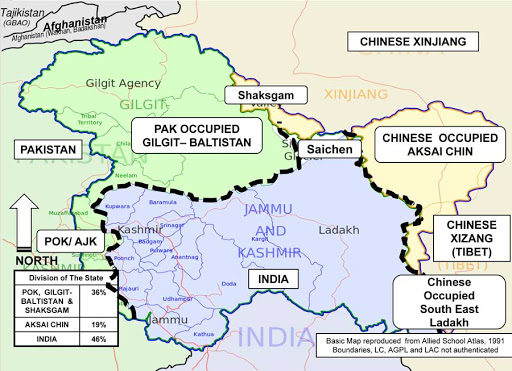Pak Occupied Kashmir
2020 MAY 6
Mains >
International relations > India and Neighbours > Indo Pak border

WHY IN NEWS?
India lodged strong protest through demarche, against the Pakistan Supreme Court’s order allowing elections to be held in Gilgit-Baltistan.
ABOUT THE ISSUE
- India marked its protest against Pakistan conducting elections in the region and reiterated that Pak institutions have no locus standi on territories illegally and forcibly occupied by it. The last elections in these Pak occupied regions were held in 2015.
- Ministry of External Affairs (MEA) clearly conveyed that the entire Union Territories of Jammu & Kashmir and Ladakh, including the areas of Gilgit and Baltistan are integral part of India by virtue of its fully legal and irrevocable accession.
- New Delhi said that Pak actions can neither hide the illegal occupation nor the grave human rights violations exploitation and denial of freedom to the people residing in Pakistan-occupied territories.
- Soon after, Indian Meteorological Department (IMD) has started referring to its meteorological sub-division of Jammu and Kashmir as Jammu & Kashmir, Ladakh, Gilgit-Baltistan and Muzaffarabad (Capital of Pok other than Gilgit-Baltistan). This move was not only related to the changed status of Ladakh as a separate Union Territory but to convey significant underlying message that the region is integral part of India.
- Pakistan has rejected the IMD move to include the region in the Indian weather forecast.
PAK-OCCUPIED-KASHMIR (PoK)
- PoK comprises the so-called Azad Jammu and Kashmir (AJK) and Gilgit-Baltistan. Pakistan ceded a part of PoK, called the Trans Karakoram Tract to China in 1963.
- The princely state of Jammu and Kashmir was ruled by King Hari Singh at the time of Partition.
- While he wanted to remain independent, armed Pashtun tribesmen from Pakistan invaded J&K in October 1947 and occupied a large tract of the province.
- The king then sought India’s help and signed the instrument of accession in return for military aid.
- This led to the first direct military conflict between India and Pakistan.
- Even as the war was underway, India sought intervention of the United Nations on 1 January 1948. UN ordered an immediate ceasefire, and part of J&K that’s now known as PoK was then under Pakistan control.
- Part of Pok so-called Azad Jammu & Kashmir has its own constitution, a prime minister and a president, though real power is vested with Pakistan. The administration of Gilgit-Baltistan was handed over to Pakistan by AJK in 1949.
- Pakistan has often rejected demands to grant Gilgit-Baltistan the status of a fifth province.
- Internal issues in the region
- In 1970s Zulfiqar Ali Bhutto abrogated a law that prevented others from acquiring land and settlement. This order damaged the social fabric and provoked sectarian feuds that continue to simmer until today.
- The region also sees Shia-Sunni and other sectarian conflicts fomented by the Pakistani establishment.
INDIA’S STAND
- India’s position has been that since the king of J&K signed the instrument of accession with India the whole of J&K including PoK is legitimately an essential part of India.
- After increasing terrorist violence and Pakistan’s attempts to highlight the Kashmir dispute internationally, both houses of Indian Parliament unanimously adopted a resolution in 1994, emphasizing J&K as an integral part of India and that Pakistan must vacate parts of the state under its occupation.
- This position has been maintained till now.
WHAT STEPS SHOULD INDIA TAKE?
- Sustain Momentum: The first and foremost challenge is to sustain the present momentum, reiterating India's claim of the region being its integral part.
- Public Awareness: There is an urgent need to widen the ambit of knowledge and awareness on both the regions before stimulating a meaningful discourse on the subject. The awareness should reach domestic and international arenas.
- Sensitise International Public Opinion: On the external front, India must undertake diplomatic efforts towards sensitising the international community about its legitimate claims on region. Indian foreign office should target especially those countries who are either involved in developmental or infrastructure projects in those places or are willing to do so.
- Political Representation: The government must give serious thought to reserving parliamentary seats for representatives from the region. The erstwhile Constitution of J&K had allotted seats in the state assembly for members from PoK, which, it noted, shall lie vacant until PoK is integrated with India. But there is no such quota in the Lok Sabha which points to something of a constitutional incongruity.
WAY FORWARD
- Many analysts have pointed to the fact that there is no such quick fix measure to regain control over PoK, unless India decides to adopt military method to seize control over the region. This is not a positive move considering India’s reputation in the global arena and its stance on non-violence.
- India needs a calibrated strategy that gradually develops itsinfluence in PoK which continues to reel under political unrest.
- Also, India should be mindful of the fact that PoK has been under Pakistan's control for over seven decades and is now incrementally falling under China's sphere of influence.
- New Delhi must carefully evolve a prudent strategy on PoK that could materialise into territorial claim on the region just as the rest of the Jammu and Kashmir.
Practice Question
Q. India has time and again retierated that the regions of Pak-occupied-Kashmir (PoK) and Gilgit-Baltistan are integral part of its territory. Discuss India's stand with respect to its claims in the region. Examine the strategies it should evolve to materialise its claims.
